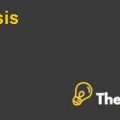INTRODUCTION
Nike Inc. is an American multinational corporation, headquartered in Beaverton, Oregon. It is one of the world’s largest suppliers of the athletic shoes and apparel and a major manufacturer of sports equipment. The objective of the company is to bring innovation to every athlete in the world. Nike creates products, services and experiences for athletes while solving problem of the next generation. The company is committed to building deeper community connections and spurring positive social change around the world.
The case addresses the issue that Nike is facing multiple challenges regarding corporate responsibility and sustainability. Moreover, Nike’s is one of the first companies faced with problems in its global supply chain to pursue sustainable innovation as a part of company’s long-term growth. The case is an extension of the previous case regarding the same issue, but the focus is wider this time (Doane 2005).
The company has designed eleven targets that are set to be achieved in the timeframe of FY 2015-2020, but the issue arises in order to select the right option, to bring change in the organization. The company faces a number of challenges and hurdles to achieve the targets for its aim that are designed by the company.
Furthermore, the Nike’s governance processes and approach to embedding sustainability into the company, embracing transparency, and pursuing innovation and creativity are considered as means to achieve a long-term goal. The case provides the targets designed by a company and company’s commitment to achieve those targets. In order to transform the company, it requires a huge investment, which may lead to loss of profits, if the strategy fails to achieve its targets.
Therefore, it is highly important that Jones and Sprunk address which area to target, select the right option and present to CR committee. However, both members decided to set strategy that should be given priority form to the two pronged strategy of the company. Therefore, the company should focus on either to invest in doing better today or in achieving the design for the future.
Jones and Sprunk need to identify the areas that require focus and will address every identified issue properly. Moreover, a thorough analysis of the situation in the paper must be conducted and the facts must be analyzed, in order to come up with better alternatives and drive possible solution.
Furthermore, the case is about strategy and execution and in order to propose strategy, it is important to conduct internal and external analysis. In the SWOT analysis, the key strengths and weaknesses will be identified, to drive the possible solution, and opportunities and threats will be admired. However, the analysis conducted will help in identifying the possible alternatives that will guide to set a goal to provide the right course of action and recommendations.
SWOT ANALYSIS
Strengths:
Nike’s major strength is product design innovation and operational capabilities. Globally, Nike has 750 stores and 48,000 employees. The competitive advantage of the company include marketing, brand loyalty and top down mission. Furthermore, the strength of the company lies in outsourcing that played a vital role in making growth attractive for the company (Marc J. Epstein 2010).
The manufacturing is outsourced in the company; therefore, immense force is invested in the marketing, and research and development department. On the other hand, the company is investing immensely, in order to make value chain attractive. Moreover, integrated sustainability in the decision making process is also one of the major strengths of the company, which leads the company to take a competitive edge.
Furthermore, the company is focusing radically towards sustainability and corporate responsibility, to achieve its targets and increase revenue in the near future. The working conditions of the company have improved and moving towards diverse working environment. The diverse working environment helps the company to gain more competitive advantage.
Governance and Sustainability at Nike Case Solution
Weaknesses:
One of the major weaknesses of the company includes contract source material and manufacturing. Moreover, the dependency of Nike on footwear has restricted the company to bring innovation in other product categories. The inability of the company to achieve the set targets for sustainability is also one of the weaknesses of the company (Connor 2010).
The global manufacturing of the company increases transportation, related to emissions. Furthermore, the toxic use material in the supply chain is a major weakness of the company that is hurting the social corporate image of the company. Apart from that, inefficient use of waters is another weakness of the company, which needs to be analyzed carefully. Moreover, the other weaknesses include internal audit process, and scope of reporting and initiatives..................
This is just a sample partial case solution. Please place the order on the website to order your own originally done case solution.












